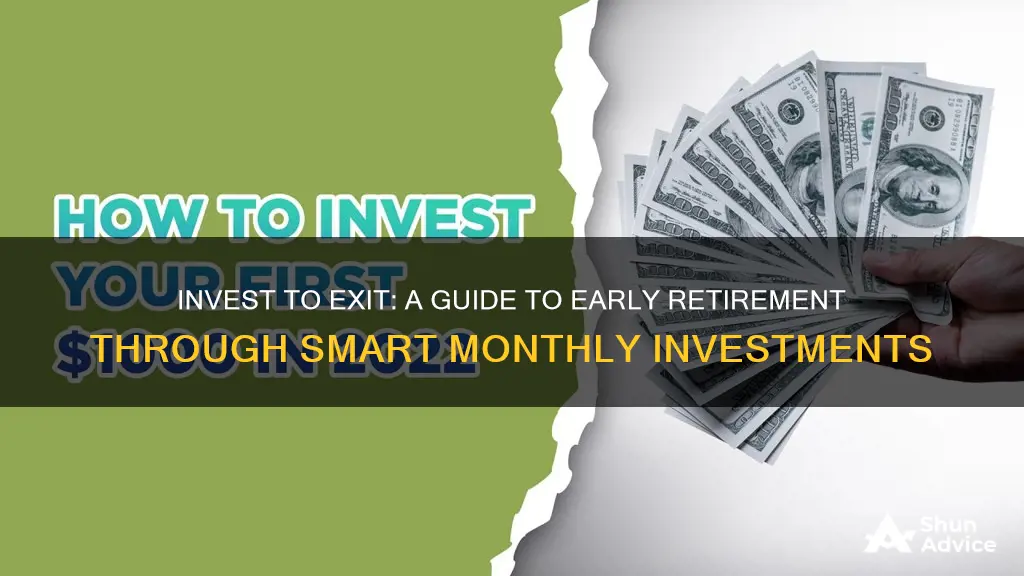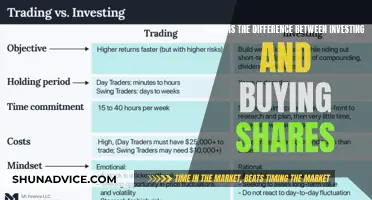
Investing $1,000 a month can be a great way to retire early, and it's never too late to start. The earlier you begin, the more time your savings have to grow through compound interest, giving you a better chance of a financially secure retirement. While it may be challenging to save such a large amount each month, there are several strategies you can employ to boost your savings and reach your retirement goals. This includes cutting your budget, increasing your income, and investing wisely.
What You'll Learn

The FIRE movement: live below your means, invest as much as possible, and retire early
The FIRE movement is an acronym for Financial Independence, Retire Early. It is a lifestyle movement that prioritises extreme saving and investing to retire earlier than traditional methods might allow. The FIRE movement is underpinned by the following principles:
- Live below your means: FIRE followers drastically reduce their expenses, with some living on 50% or less of their income. This often means cutting expenses to the bare minimum.
- Invest as much as possible: FIRE followers invest heavily, with a focus on tax-advantaged accounts and regular brokerage accounts. They typically save 25 times their annual expenses and withdraw 3-4% of their savings annually.
- Retire early: The ultimate goal of the FIRE movement is to achieve financial freedom so followers can choose how to spend their time. This could mean scaling back to a part-time job or stopping work altogether.
The FIRE movement is not for everyone. It requires strict expense cuts and a large income to save enough to retire early. However, the principles of the FIRE movement can help anyone retire earlier. For example, increasing income, saving and investing more, and cutting back on expenses.
Ratios Reveal: Investing Insights
You may want to see also

Calculate how much you'll need each month in retirement
To calculate how much you'll need each month in retirement, you should consider the following:
Current Income and Expenses
Firstly, you need to know your current income and expenses. This will help you understand how much money you need to live comfortably. You can then assume that you will need slightly less in retirement, as some expenses will disappear. A common rule is to budget for at least 70% of your pre-retirement income during retirement.
Future Expenses
Next, you should consider what your expenses might be in retirement. Do you plan to travel? To eat out? Go to the movies? Move closer to family? These questions may seem trivial now, but they can help give you an idea about the income you'll need in the future.
Retirement Income
You should also consider your sources of income in retirement. This might include Social Security, pension benefits, or other passive income. You can use this information to calculate how much extra you will need each month.
Savings
Finally, you need to consider your savings. How much have you saved so far? How much can you save each month? How many years do you have left until retirement? Answering these questions will help you understand how much you need to save to reach your retirement goals.
There are many online retirement calculators that can help you with these calculations. They will take into account your current income, expenses, savings, and expected retirement income to give you an estimate of how much you will need each month in retirement.
Retiring Early: A 15-Year Investment Strategy for Financial Freedom
You may want to see also

Save enough to cover living expenses and emergencies
Saving enough to cover living expenses and emergencies is a crucial aspect of planning for early retirement. Here are some detailed instructions to help you achieve this:
Calculate your living expenses:
Start by understanding your current monthly spending and identify areas where you can cut back. Consider essential expenses such as housing, utilities, transportation, and food, and any other regular payments. Also, factor in costs that may increase or decrease in retirement, such as travel or healthcare.
Determine your savings goal:
The general rule of thumb for retirement savings is to have 25 times your planned annual spending. This means that if you estimate you'll spend $50,000 per year during retirement, you should aim for a nest egg of $1,250,000. This will provide you with financial security and ensure your savings last throughout your retirement.
Create a budget and save aggressively:
Once you know your target savings, create a budget that maximizes your savings rate. Consider following principles of the FIRE movement (Financial Independence, Retire Early), which encourages living below your means and investing as much as possible. Look for ways to increase your income, such as through side hustles or investments, and funnel that extra money into your savings.
Build an emergency fund:
It's important to have a dedicated emergency fund separate from your retirement savings. Aim to save three to six months' worth of essential living expenses in a high-yield savings account or money market account. This will provide a cushion for unexpected expenses, such as car repairs or medical bills, and prevent you from dipping into your retirement savings prematurely.
Make your savings work for you:
Invest your savings in a balanced portfolio geared toward long-term growth. Consider low-cost index funds with a focus on stocks to maximize returns. The goal is to generate investment returns that outpace inflation, ensuring your savings retain their purchasing power over time.
Stay disciplined:
Sticking to your savings plan can be challenging, especially when faced with lifestyle inflation or unexpected expenses. It's important to monitor your spending and make adjustments as necessary to ensure you're on track. Remember, the goal of early retirement is financial independence, so staying disciplined with your savings and investments will help make that dream a reality.
Gladstone Investment: Unlocking Monthly Dividend Potential
You may want to see also

Take advantage of compound interest by starting early
The sooner you start saving for retirement, the better. Even if you're past your 20s, a consistent savings plan can help you take advantage of compound interest. Compound interest is when you earn interest on both the capital you have invested and the interest you have already received. It allows money to grow exponentially over time and can help savers and investors to turn small capital sums into large cash piles over many years.
Compound interest is your friend when it comes to savings and investments, as it multiplies your money at an accelerated rate. The higher the number of compounding periods, the larger the effect of compounding. For example, if you invest £100,000 in a bank account for 10 years with an annual interest rate of 4%, you would receive £4,000 in interest income in the first year, £4,160 in the second year, and £5,693.24 in the tenth year. Your total cash pot after 10 years would be worth £148,024.43.
The Rule of 72 is a way to estimate compound interest. If you divide 72 by your rate of return, you can find out how long it will take for your money to double in value. For example, if you have $100 that was earning a 4% return, it would grow to $200 in 18 years (72/4 = 18).
The power of compound interest is that it grows at an ever-accelerating rate. Over 10 years, a $100,000 deposit receiving 5% simple annual interest would earn $50,000 in total interest. But if the same deposit had a monthly compound interest rate of 5%, the interest would add up to about $64,700.
The number of compounding periods is just as important as the interest rate. The earlier you start saving, the more compounding interest can work in your favour, even with relatively small amounts. For example, if you start saving $100 a month at age 20 and earn an average of 4% annually, compounded monthly, you would have $151,550 by age 65. However, if you don't start investing until age 50, you would only have $132,147 by age 65, even with a larger principal investment of $95,000.
Therefore, to take advantage of compound interest, it is important to start saving for retirement as early as possible and to be consistent with your payments.
Stable Interest Rates: Investors' Confidence Boost?
You may want to see also

Get your employer's 401(k) match
Getting your employer to match your 401(k) contributions is a great way to boost your retirement savings. Here are some key things to know about maximising your employer's 401(k) match:
Understanding the Basics
K) matching refers to when your employer contributes a certain amount to your retirement savings plan, based on the amount you contribute. This is essentially "free money" that can significantly enhance your retirement fund. The specific terms of 401(k) plans vary, but typically, employers match a percentage of employee contributions up to a certain limit, which may be a percentage of your total compensation or a fixed dollar amount.
Types of Matching
There are two common types of 401(k) matching: partial matching and full matching (dollar-for-dollar). With partial matching, your employer matches a fraction of your contribution, usually 50%, up to a certain percentage of your salary. For example, they might match 50% of your contributions up to 6% of your salary. On the other hand, with full matching, your employer contributes the same amount as you do, up to a certain percentage of your salary. So, if you put in 4%, they put in 4%.
Vesting Schedules
It's important to understand vesting schedules, which dictate how much of your employer's contributions you actually own, based on the number of years you've been employed. Even if your employer offers generous matching, you may forfeit some or all of those contributions if you leave the company before a certain number of years have passed. A typical vesting period is five years. Your own contributions are always 100% vested and cannot be forfeited.
Maximising Your Match
To make the most of your employer's 401(k) matching:
- Start contributing immediately, even if your employer has a waiting period for matching.
- Always contribute enough to get the full match—don't leave free money on the table.
- Sign up for automatic payroll deductions so a set amount goes into your 401(k) each pay period.
- Resist the temptation to withdraw funds during market downturns. Stay the course and ride out the volatility.
Nokia: Invest Now or Miss Out?
You may want to see also
Frequently asked questions
This depends on several factors, including your age, the interest rate on your investments, and whether you have any employer matches. For example, if you start investing at age 20 and earn a 4% return, you'll have $1.6 million by the time you retire. If you start at 30, you'll still earn over $1 million.
There are several ways to invest $1,000 a month for early retirement. You can contribute to a traditional or Roth IRA, get your 401(k) employer match, invest with a robo-advisor, or open a brokerage account. You can also use the $1,000 per month retirement rule, which states that for every $240,000 you have set aside, you can withdraw $1,000 a month (5% per year).
It's important to remember that retiring early requires a lot of work and financial discipline. You'll need to make adjustments to your current budget, calculate your annual retirement spending, and estimate your total savings needs. It's also crucial to invest for growth and keep your expenses in check during retirement.







